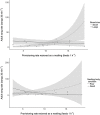The effect of early life conditions on song traits in male dippers (Cinclus cinclus)
- PMID: 30427834
- PMCID: PMC6235254
- DOI: 10.1371/journal.pone.0205101
The effect of early life conditions on song traits in male dippers (Cinclus cinclus)
Abstract
Song complexity and singing frequency in male birds are shaped by female choice; they signal male quality because song is costly to develop and produce. The timing of song learning and the development of the brain structures involved occur during a period when chicks are exposed to a number of potential stressors. The quality and quantity of song produced by adults may therefore reflect the level of stress experienced during early life, a theory known as the 'developmental stress hypothesis'. We tested this hypothesis using song recordings and life-history data from an individually marked, long-term study population of wild dippers (Cinclus cinclus). The extent to which early life conditions predict adult song traits was investigated using natal brood size as a measure of sibling competition; the rate of provisioning by parents as a proxy for nutritional stress; and residuals of the linear regression between body mass and tarsus length as a measure of nestling condition. The syllable diversity in the songs of adult males was positively correlated with their body condition as nestlings, but there was no significant correlation with either provisioning rate or brood size. Provisioning rate did, however, predict song rate; males in relatively poor condition as nestlings or those raised in smaller broods which were fed more frequently by their parents sang at a higher rate in adulthood. These results support the developmental stress hypothesis and provide some of the first evidence from a wild bird of how the conditions experienced during early life impact adult song. Song traits may therefore provide females with information regarding both the current condition and developmental history of males.
Conflict of interest statement
The authors have declared that no competing interests exist.
Figures


References
-
- Searcy WA, Yasukawa K. Song and Female Choice. Ecology and Evolution of Acoustic Communication in Birds. 1996.
-
- Catchpole CK, Slater PJB. Bird song-biological themes and variations. Cambridge Universty Press; 2008.
-
- Ward S, Speakman JR, Slater PJB. The energy cost of song in the canary, Serinus canaria. Anim Behav. 2003;66: 893–902. 10.1006/anbe.2003.2250 - DOI
Publication types
MeSH terms
LinkOut - more resources
Full Text Sources

